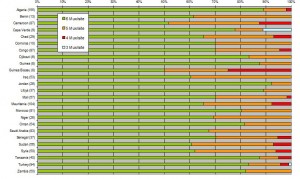The study was undertaken to investigate the scope for releasing digital dividend frequencies. High level analysis was undertaken of the impact of removing channels 61 – 69 on countries in the Middle East and Africa. The data on the proposed TV channel use was sourced from the ITU RRC 06 Planning Interface database, which contains details of all frequency assignments in the UHF TV bands (including non-broadcast services that countries wished to be protected during and after digital switchover). For each country the number of sites that could deliver six national multiplexes (in line with most European countries’ thinking) was examined assuming the absence of channels 61 – 69.
The output was a comparison of the percentage of total sites per country that could support six multiplexes or less as shown below. The figures in brackets after the country name indicate the total number of sites in the country according to the RRC 06 data.

In addition a more detailed analysis of the current use of the UHF TV band and plans for digital switchover was provided for four representative countries, namely Russia, Iran, Nigeria and South Africa. Account was also taken of other existing services such as radiolocation and fixed services in Russia. The impact of a second refarming option (channels 56 – 69 inclusive) was also provided for these countries.
